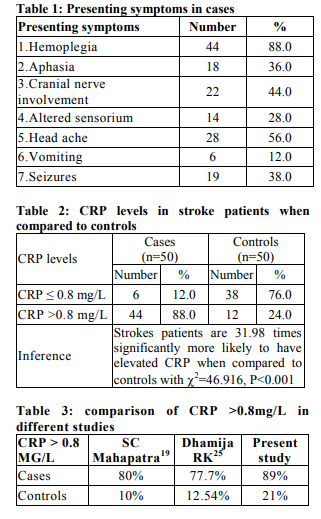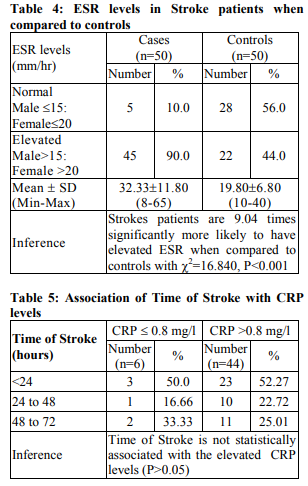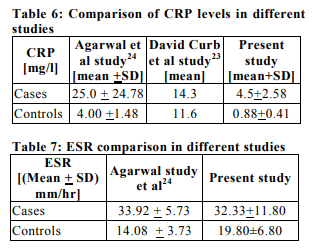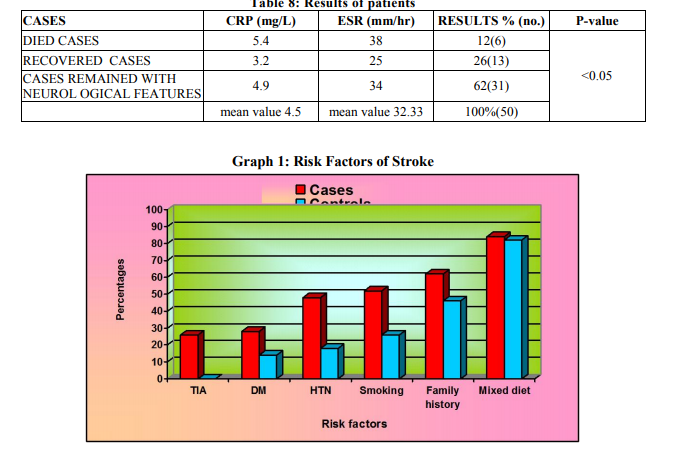IJCRR - 5(2), January, 2013
Pages: 127-134
Date of Publication: 26-Jan-2013
Print Article
Download XML Download PDF
STUDY OF PROGNOSTIC SIGNIFICANCE OF SERUM C-REACTIVE PROTEIN AND ESR IN ACUTE ISCHEMIC STROKE
Author: Krishna Murthy H.A., Renuka Prasad Y.S.
Category: Healthcare
Abstract:Background of the study: The stroke is defined as rapidly developing clinical signs of focal or global disturbance of cerebral function, lasting more than 24 hrs or leading to death, with no apparent cause other than vascular origin.1,2 An increasing body of evidence has linked inflammation with the pathogenesis of atherothrombotic stroke. The serum C-reactive protein (CRP) and ESR are acute-phase reactants, are indicators of underlying inflammation of endothelium and novel plasma markers for atherothrombotic disease.3,4,5 Aims and objectives: 1. To study the serum concentration of C-Reactive Protein [CRP] and ESR in patients of Acute ischemic stroke. 2. To compare it with that of age and sex matched controls. 3. One month follow up of the cases to know the results of stroke. Methods: It is a case control study, in this 50 cases, who has CT brain confirmed, first attack of Acute ischemic stroke and 50 healthy controls were taken. For all patients CRP and ESR levels were measured, with in 72 hours of onset of stroke and followed up for one month to know the results of cases. Results: The mean serum CRP level among the cases was 4.5\?2.58mg/L and that among the controls it was 0.88\?0.41 mg/L with the p value of < 0.001. There were 88% (44) of cases and 24% (12) of controls has CRP levels >0.8mg/L and 12%(6) of cases and 76%(38) of controls has CRP levels < 0.8mg/L. The mean ESR value among the cases and controls in the present study was 32.33+11.80mm/hr and 19.80\?6.80mm/hr respectively. After one month of follow up 12%(6) of cases with serum CRP value of 5.4mg/L and ESR of 38mm/hr were died, 26%(13) of patients with serum CRP value of 3.2mg/L and ESR of 25mm/hr were recovered from neurological features and 62%(31) of patients with serum CRP value of 4.9mg/L and ESR value of 34mm/hr were remained with same neurological features, which was statistically significant with the p value of < 0.05, deaths were seen in highly raised CRP and ESR cases. Conclusion:The serum CRP and ESR levels were higher in the cases compared to controls and the statistically significant results were also seen with the follow up of the cases.Hence it can be concluded that,inflammation is an important risk factor of endothelial damage and atherosclerosis.So measures to reduce the inflammation of endothelium and atherosclerotic plaque of blood vessels, in the long run can significantly reduce the incidence of stroke and its consequences in predisposed individuals.
Keywords: Acute ischemic stroke, CRP, ESR.
Full Text:
INTRODUCTION
The WHO defined, stroke as “rapidly developing clinical signs of focal or global disturbance of cerebral function, lasting more than 24 hrs or leading to death, with no apparent cause other than vascular origin”. The stroke manifests by various neurological signs and symptoms depends on the area, extent of involvement and the underlying causes. These include hemiplegia, monoplegia, cranial nerve palsy, sensory impairment, paraplegia and speech disturbances etc. Of these, about 90% of patients have hemiplegia as the most common presentation. 1,2 The many studies have shown that, the inflammation has a significant role with the pathogenesis of atherosclerotic stroke. The inflammation may induce atherosclerosis by increasing the serum levels of cytokines, fibrinogen, clotting factors, and leukocytes by altering the functions of endothelial cells.The serum C-reactive protein (CRP) and ESR are acute-phase reactants, are markers of underlying systemic inflammation and novel plasma indicators for atherosclerosis. Some clinical trials have shown, an association between high concentration of serum C-Reactive Protein [CRP], ESR and ischemic strokes.3,4,5 Not many studies are available on rise in serum CRP and ESR levels in acute ischemic stroke. It was therefore, planned to study serum CRP and ESR levels in acute ischemic stroke, and to compare these levels with those obtained in healthy controls.
C-Reactive protein
C-reactive protein was discovered by Tillet and Francis in 19306 . Inflammation is an important feature of atheroma and is associated with activation and proliferation of macrophages, endothelial cells and smooth muscle cells7 . The serum CRP and ESR are the earliest acute phase reactants to increase during the inflammatory response. Today, however, the best single test of acute inflammation is a serum CRP level that can be readily quantified by nephelometry.8 The median circulating concentrations of C - reactive protein is 0.8 mg/L. Normal range may be as low as 0.07 mg/L and among apparently healthy individuals 90% have less than 3 mg/L .9 The rate of CRP synthesis and secretion increases within hours of an acute injury or the onset of inflammation10, probably under the influence of humoral mediators such as leucocyte endogenous mediator (endogenous pyrogen) 11 and prostaglandin PGE. The serum CRP concentration may reach peak levels as much as 300mg/ml within 24-48 hours12. The Edward T.H. Yeh, MD showed that both statins and finofibrates can inhibit CRP induced MCP-1 induction.13
The Erythrocyte Sedimentation Rate (ESR);14,15
ESR is a simple and inexpensive laboratory test for assessing the inflammatory or acute response.The ESR was also an independent predictor of short-term stroke outcome. An ESR > 28mm/hr was associated with a poorer prognosis.
Aims and objectives
1. To study the serum C - reactive protein [CRP] level and ESR in patients of acute ischemic stroke.
2. To compare it with that of age and sex matched controls
3. One month follow up of cases to know the results.
MATERIALS AND METHODS
Source of data:
Patients with clinical and CT Brain diagnosed first ischemic stroke admitted to VICTORIA and BOWRING AND LADY CURZON Hospitals, BMC ,Bangalore were studied with equal number of age and sex matched healthy volunteers as controls with one month of followup for cases.
Method of collection of data
Study Design: The study is the case control study in which cases and controls were selected by considering of inclusion and exclusion criteria. Detailed history was taken, clinical examination was done as per proforma and the necessary investigations were done for both cases and controls.
Inclusion Criteria:
All patients of clinical and CT scan brain confirmed first ischemic stroke admitted within 72hrs of symptom onset and healthy age and sex matched volunteers who are relatives of the patient.
- Acute infectious disease
- All patients of stable or unstable angina, acute myocardial infarction.
- Immunological disorders.
- Known or suspected neoplastic disorders
- Recent [less than 3 months] major trauma, surgery, burns
- Osteoarthrosis, costochondritis, rheumatoid arthritis, ankylosing spondylitis.
Sample Size:
50 cases were studied with equal number of controls.
Protocol of the study:For every case and control selected, clinical data and results of routine investigations were prospectively recorded.In both cases and controls, blood for CRP and ESR was taken by performing venipuncture and estimation was done in Clinical Microbiology Laboratory, BMC, Bangalore with the follow up of patients for one month to know the condition and results.
Procedure: The serum C - reactive protein and ESR estimation.
Principle: The serum CRP is a rapid slide agglutination procedure for the direct detection and semiquantitation of C-reactive protein. The reagent, a latex particle suspension coated with specific antihuman C- reactive protein antibodies, agglutinates in the presence of CRP in patients serum.8,16,17,18
Positive Results: The presence of agglutination indicates content of CRP in the sample equal to or greater than 0.8mg/L.
Negative Results: Homogenous suspension of fluid (lack of agglutination) indicates a CRP level lower than 0.8mg/L. The detection limit of this test is 0.8 mg/L. therefore, values of less than 0.8 mg/L were taken as normal concentration of CRP. Values of more than 0.8 mg/L were taken as elevated CRP.16,17,19 .
ESR Level Estimation; 20
METHOD; The International Committee for Standardization in Hematology (ICSH) recommends the use of the Westergren method. Normal values are 15 mm/hr or less for men and 20 mm/hr or less for women.20 The ethical clearance was taken from Bangalore Medical College Ethical Commitee,Bangalore. The written consent from all the participants was taken after explaining in their own language about the study , methods used on them and risks involved.
RESULTS AND OBSERVATIONS
In this study majority of cases were in the age group of 42-70years constituting 58% of cases. In the control group majority were in the age group of 41-60 years, constituting 64%. The mean age for cases and controls were 55.60±14.68years and 51.50±8.36 years respectively. In the present study the most common mode of presentation of CVA was hemiplegia in 88% followed by cranial nerve palsy [VII] in 44%, aphasia in 36% and altered sensorium in 28%. Headache was present in 56% of cases. Seizure was a symptom in 38% of cases along with other complaints (table1). In the present study of 50cases and equal number of controls, the risk factors seen are smoking, constituting [50% Vs.28%], hypertension [ 46% vs. 20%], diabetesmellitus [27%Vs.16%], Familyhistory [59%Vs.44%], Mixeddiet [85%Vs.84%] among cases and controls respectively(graph1). TIA was present in 27% of cases only. The mean CRP level in the present study is 4.5±2.58mg/L among the cases and 0.88±0.41mg/L among the controls respectively, which is statistically significant with the p value of 0.8mg/L was present in 88% compared to controls who had 0.8mg/L in 24% respectively (table3). In this study ESR was raised in 90% of cases and 44% of controls, with the mean value of 32.33±11.80mm/hr and 19.80±6.80mm/hr respectively (table4). In 50% (23) cases CRP level was more than 0.8mg/l with in 24hours of onset of Stroke.In16.66% of cases between 24 to 48 hours and in 33.33% of cases between 48 to 72hours, the serum CRP level was raised above the normal level.But time of Stroke was not statistically associated with elevated CRP levels (table5). After one month of follow up 12%(6) of cases with CRP value of 5.4mg/L and ESR of 38mm/hr were died, the 26%(13) of patients with CRP value of 3.2mg/L and ESR of 25mm/hr were recovered from neurological features and 62%(31) patients with CRP value of 4.9mg/L and ESR of 34mm/hr were remained with same neurological features, which was statistically significant with the p value of <0.05(table8).
Statistical Methods21,22:
The Chi-square and Fisher exact test have been used to test the homogeneity of sex distribution and Student t test has been used to test homogeneity of age distribution. Chi-square and Fisher exact test have been used to find thesignificance of proportions of study parameters between cases and controls. Student t test (two tailed) has been used to find the significance mean pattern of study parameters between cases and controls.
Statistical software: The Statistical software namely SPSS 11.0 and Systat 8.0 were used for the analysis of the data and Microsoft word and Excel have been used to generate graphs, tables etc.
DISCUSSION
The present study is a hospital based case control study with 50 cases and equal number of age and sex matched controls. The serum CRP and ESR levels were estimated in both the groups and compared.One month follow up done to know the results of the cases. In the present study the age of cases and controls were 55.60±14.68 years and 51.50±8.36 years respectively. This suggests that ischemic stroke is mainly find in the middle age group patients.The percentages of smokers in the present study were 50% among cases and 28% among the controls. In the study by Curb et al23 54.4% of cases and 37.6% of controls were smokers and in the study done by Natalia S Rost, 3 the 22.7% of cases were smokers. In the present study 27% were diabetics among the cases and 16% among the controls, the 46% of cases were hypertensive, whereas only 20% of controls were having hypertension as risk factors. In the study done by Curb et al,23 the 27.0% of cases and 13.3% of controls were diabetics,the 27% cases and 10.6% of controls were hypertensives. So diabetes mellitus and hypertension are the main risk factors of ischemic stroke. The mean CRP level in the present study is 4.5±2.58mg/L among the cases and 0.88±0.41mg/L among the controls respectively, which was statistically significant with the p value of <0.001. These findings were compared with, the study done by David Curb et al 23 , where the mean CRP level among the cases and controls were 14.3mg/L and 11.6mg/L respectively and In the study done by Agarwal et al24, the mean CRP values in both the cases and the controls were 25.0 + 24.78mg/L and 4.0+ 1.48mg/L respectively. The difference between cases and the controls were statistically significant. In the present study 88% of cases and 24% of controls has CRP level >0.8mg/L. In the study by S C Mahapatra et al 19 80% of cases and 10% of controls has CRP level >0.8mg/l. In the study done by Dhamija R K et al, 25 the 77.7% of cases and 12.54% of controls has CRP>0.6mg/L (table6). By these observations we can be sure that inflammation is an important risk factor of endothelial damage. The mean ESR level among the cases and controls in the present study is 32.33±11.80mm /hr and19.80±6.80mm/hr respectively.Which was comared with the study done by Agarwal et al24 ,where the values were 33.92mm /hr and 14.08mm /hr among the cases and controls respectively (table7). In follow up of for one month,the 12% cases with serum CRP value of 5.4mg/L and ESR of 38mm/hr were died and 62% patients with serum CRP value of 4.9mg/L and ESR of 34mm/hr were remained with same neurological features.The death was seen in highly raised serum CRP and ESR cases. Again this proves that, the inflammation is an imporatant risk factor of endothelial damage. A study done by Muir et al. had shown that CRP levels within the first 72 hours after an acute ischemic stroke are an independent marker for predicting survival26 . Our study had shown that the third day CRP levels of patients who died within the first 30 days were significantly higher than the surviving patients. It has been proved that a large cortical infarcts patients have a higher CRP values than normal at the time of presentation and the prognosis is worse in patients with increased CRP levels. 3 Our study shows that patients who could walk independently at the end of the study duration have the lowest CRP value. The increased CRP levels in patients who died and the lowest CRP levels in the walking group may be an indicator of the level of underlying inflammation. By our study and other new literature suggests that CRP and ESR are prognostic markers of atherosclerosis.
CONCLUSION
The serum CRP and ESR levels were higher in the cases compared to controls and the statistically significant results were also seen with the follow up of the cases.Hence it can be concluded that, inflammation is an important risk factor of endothelial damage and atherosclerosis. So measures to reduce the inflammation of endothelium and atherosclerotic plaque of blood vessels, in the long run can significantly reduce the incidence of stroke and its consequences in predisposed individuals.
ACKNOWLEDGEMENT
Authors acknowledge the great help received from the scholars, whose articles cited and included in references of this manuscript. The authors are also grateful to authors / editors / publishers of all those articles, journals and books from where the literature for this article has been reviewed and discussed. Authors are grateful to IJCRR editorial board members and IJCRR team of reviewers who have helped to bring quality to this manuscript.
References:
1. WHO, Technical Report Series 1976:469.
2. Aho K, Harmsen P, Hatano S, et al. Cerebrovascular disease in the community: results of a WHO collaborative study. Bull World Health Organ 1980; 58(1): 113-130
3. Natalia S .Roast, Philip A Wolf, Carlos S, Kase et al,’’Plasma concentration of Creactive protein and risk of ischemic stroke and trancient ischemic attack’’. The Framingham Study. Stroke Nov 2001;32;2575-2579
4. Guo Y, Jiang X, Zhou Z, Chen S, Zhao H, Li F ‘’Relationship between levels of serum creactive protein,leucocyte count and carotid plaque in patients with ischemic stroke’’ JHuazhong Univ Sci Technolog Med Sci . 2003;23[3];263-5.
5. Di Napoli M, Papa F, Bocola V. “Prognostic Influence of increased CRP and fibrinogen levels in ischemic stroke”. Stroke 2001;32:133-138;917-924
. 6. Tillet WS, Francis T, “Serological reactions in peneumonia with a non protein somatic fraction of pneumococcus”, J Exp Med., 1930;52;561-571.
7. Paul M Ridker, MD; Peter W.F. Wilson, MD; Scott M. Grundy, MD.”Should C-Reactive Protein be added to metabolic syndrome and to Assessment of Global Cardiovascular Risk?”. Criculation 2004;109:2818-2825
8. David F Keren, Jeffrey S. Warren. “Diagnostic immunology” 1992; 57-58.
9. Pepys MB, “The acute phase response and Creactive protein”, Chapter 11, 13.3 in Oxford Text book of Medicine, 3rd Edition, Weathurall DJ, Ledingham JGG, Warrell DA, Tokyo: Oxford University Press, 1906; 1527-1533.
10. Kushner I, Feld Man G, “Control of acute phase response Demonstration of C-reactive protein sysnthesis and secretion by hepatocytes during acute inflammation in the rabbit”, J. Exp Med, 1978, 148;466-77.
11. Merriman CR, Pulliam LA, Kampschmidt RF, “Effect of leukocytic endogenous mediator on C-reactive protein in rabbits” Proc Soc Exp Bio Med 1975;149;782-84.
12. Wade S. Smith, Stephen L. Hauser, Donald Easton. Cerebrovascular diseases. Harrison’s principles of internal medicine.16th edition. (Eds). Dennis L. Casper, Anthony L. Fauci, Dan L. Longo, Eugene Braunwald, Stephen L. Hauser. McGraw-Hill 2004.
13. Edward T.H. Yeh, MD. “CRP as a Mediator of Disease”. Circulation 2004; 109(Suppl II):II-11-II-14.
14. Sox HC, Liang MH: The erythrocyte sedimentation rate. Ann Intern Med 1986; 4:515-523
15. A.Chamorro, Md; N. vila, Md; Early prediction of stroke severity, role of the erythrocyte sedimentation rate. STROKE. 1995;26:573-576.
16. Shine B, De Beer FC, Pepys MB, “Solid phase radioimmuno assays for CReactive protein”, Clin CHem Acta 1981;117;13-23.
17. Oliveria EB, GOtschlich EC, Liu T, “Comparative studies on the binding properties of human and rabbit C-reactive protein”, J Immunol 1980;124;1396-402.
18. Tsujimoto M, Inoue K, Mojima S, “Creactive proteininduced agglutination of lipid suspensions prepared in the presence and absence of phosphatidlyl choline”, J. Biochem 1980;87;1531-37.
19. S C Mahapatra,PK Pillai,PK Hui,SK Tripathy, BK Behera,KK Samal “C-Reactive proteins in Thrombotic stroke” JAPI. Vol50;Dec2002
20. International Council for Standardization in Haematology (Expert Panel on Blood Rheology): ICSH recommendations for measurement of erythrocyte sedimentation rate. J Clin Pathol 1993; 46:198-208
21. Bernard Rosner (2000), Fundamentals of Biostatistics, 5th Edition, Duxbury.
22. M. Venkataswamy Reddy (2002), Statistics for Mental Health Care Research, NIMHANS publication, INDIA
23. J.David Curb, Robert D Abbott, Beatriz L Rodriguez et al ‘’CRP and the future risk of Thrombo embolic stroke in healthy men.’’Circulation April 2003,22,107[15].
24. Agarwal MP, Singh NR, Kaur IR. “CReactive Protein in acute cerebralinfarction”.JAPI. Vol51;Dec 2003
25. Dhamija RK, Gaba P, Jais M, Kumar M, Sherwal BL ‘’A Study of C-Reactive Protein levels in patients of Acute Ischemic Stroke and its correlation with lipids’’ JAPI.Vol51,Dec2003.
26. Muir KW, Weir CJ, Alwan W, Squire IB, Lees KR. C-reactive protein and outcome after ischemic stroke. Stroke. 1999;30(5):981–985.




List of abbreviations used; CRP-Creactiveprotein; ESR-Erythrocyte sedimentation rate.
|






 This work is licensed under a Creative Commons Attribution-NonCommercial 4.0 International License
This work is licensed under a Creative Commons Attribution-NonCommercial 4.0 International License